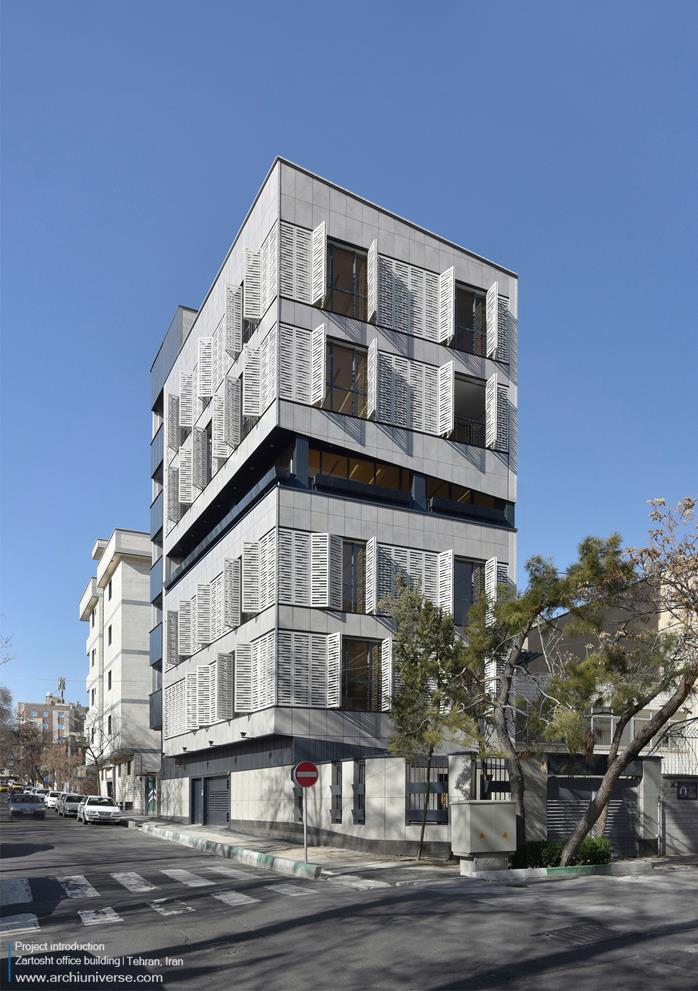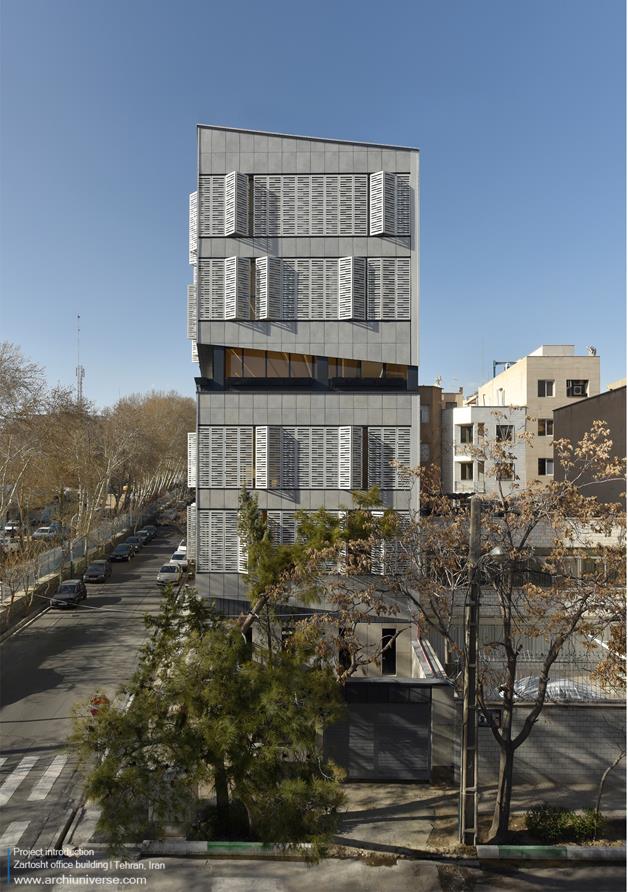- خانه
- معرفی پروژه
- طراحی معماری
- ساختمان اداری زرتشت
منو
منو














سایت پروژه اداری زرتشت که مربوط به یک شرکت کامپیوتری است در نبش تقاطع دو خیابان دایمی و زرتشت غربی قرار گرفته است. این پروژه اداری دارای دو طبقه همکف و منهای یک به عنوان زیر زمین و پنج طبقه اداری بروی آن است. سایت قرارگیری پروژه از غرب به زمین های سازمان آب و نیز پارک لاله به عنوان یکی از پارک های قدیمی و بزرگ تهران مشرف است. خیابان زرتشت خیابانی موازی خیابان فاطمی به عنوان یکی از خیابان های اصلی مرکز شهر با بافت اداری مسکونی می باشد. منطقه قرارگیری بنا طی سال های اخیر تغییراتی یافته است به گونه ای که بافت قدیمی آن متشکل از خانه های ویلایی مسکونی یک و دو طبقه بوده اما هم اکنون طی دو دهه اخیر ساختمان های اداری پنج طبقه در حال سر بر آوردن است.
این ترکیب بندی باعث ایجاد نوعی از همنشینی است که در عین تضاد در حجم و توده ساختمان ها، به لحاظ اختلاط دو نوع کاربری مسکونی و اداری قابل پذیرش است چرا که حیات و امنیت فیزیکی و روانی منطقه را تضمین می کند. سوال اصلی طراحی پروژه این است که آیا میتوان تفاوت مقیاس و توده های این دو کاربری در قالب فرم شهری جدیدی ارایه شود به گونه ای که فرم و الگوی جدید شهری همگون با بافت زمینه را فراهم آورد یعنی ساختمانی که هر دو دو مقیاس و کاربری را در آن واحد در بر داشته باشد. برای نیل به این هدف ارتفاع پایه، دو طبقه مسکونی منطقه در نظر گرفته شد و طبقه سوم همانند یک شکاف حجم طبقات بالاتر را از حجم پایه جدا ساخت به این ترتیب ساختمان همانند دو جعبه قرار گرفته بروی هم و شکافی مابین آنهاست.
در عمل ساختمان همانند دو جعبه ای بر روی هم قرار گرفته است. جعبه پایین هماهنگ با بافت مسکونی دو طبقه قدیمی منطقه است و حجم جعبه ای در طبقات بالاتر که به دلیل قرارگیری بروی شکاف طبقه سوم حس تعلیق داشته در نتیجه از حجم یکپارچه و عظیم بنا می کاهد. شکاف مابین طبقات رو سوی پارک لاله باز شده است و طبقه ای متفاوت نسبت به سایر طبقات را ایجاد کرده است این طبقه. در این طبقه بدنه ای تمام شیشه ای ۸۰ سانتیمتر عقب تر از لبه نما و این لبه به تراس همراه با گلدان های سراسری اختصاص یافته است. این طبقه متفاوت البته به لحاظ کاربری نیز بخش فروش ساختمان اداری است به این دلیل می بایست ویژه تر و متمایز از طبقات دیگر طراحی آن صورت می گرفت.طبقات اول و دوم بخش تعمیرات و نگهداری و طبقات چهارم و پنجم مربوط به بخش تحقیق و توسعه و نیز مدیریت است. در طرح اولیه به منظور ایجاد تفاوت جدی تر باکس جعبه ای بالا تمام شیشه ای همراه با تراس هایی در دوسو بود که توده ای آینه ای و متخلخل را ایجاد نماید که البته مورد توافق کارفرما قرار نگرفت. در طبقه همکف تاکید بر این بود که حیاط کوچک بنا بدون دیوار باشد و حیاط در اختیار شهر قرار گیرد که این و موضوع نیز مورد توافق کارفرما قرار نگرفت.
در طراحی نمای این ساختمان سعی بر این شد که شیوه ای نوین و جدید استفاده شود و شیوه سنتی که مبتنی بر استفاده از ملات و روش تر بود به کل حذف گردد. به همبن دلیل کل نما در طبقات به مدول های ۶۰ سانتیمتری تقسیم شد که تعدادی از آنها ثابت و تعدادی دیگر که مقابل بازشو ها قرار گرفته است قابلیت حرکت و باز و بسته شدن را دارد. این پانل های از جنس ورق با اتصالاتی در بالا و پایین به سازه اصلی است و پشت آن لایه هوایی قرار گرفته است. بدین ترتیب این لایه بیرونی همانند لایه ای محافظ بدنه را از تابش شدید محافظت می کند. فاصله بین طبقات نیز با سرامیک و به روش خشک اجرا شده است. مدول بندی باعث شد که تمامی قطعات نما پس از آماده شده به صورت پیش ساخته بروی بدنه نصب گردد. پترن های اجرا شده بروی بدنه ها نیز در زمان های مختلف روز نور ها و سایه های متفاوت را در فضای داخلی ایجاد می کند و این موضوع از زمان شروع ساعت تا انتهای روز کاری ادامه می یابد.
The site of Zartosht office project, which belongs to a computer company, is located at the intersection of two streets: Daeimei and Western Zaratosht
This official project has two floors, namely ground floor and minus one floor, as underground and five official floors above them. The project site overlooks from west the Water Organization and Laleh Park as one of the old and famous parks in Tehran. Zartosht Street is parallel to Fatemi Street as one of the main streets of the city center with residential-official zone. The area in which the site is located has witnessed some changes in recent years, where its old composition consisted of one and two-story residential villa houses; however, over the past two decades, five-storey official buildings are prospering at this area. This combination creates a kind of association that, while contradicting the volume and mass of buildings, is acceptable in terms of mixing residential and official usages, as it ensures the physical and psychological safety and security of the area
The main question of the project design is whether the difference in scale and masses of these two usages can be presented in the form of a new urban form in such a way that it provides a new urban form and pattern congruence with the background context, that is, a construction that simultaneously contains both scale and usage. In order to achieve this goal, the base height is considered two residential floors of the area and the third floor, like a slit, separates the higher floors from the base volume so that the building looks like two boxes mounted on each other and a split between them
In practice, the building is like two boxes mounted on each other. The bottom box is in harmony with the two-storey residential texture of the area, and the volume of the box in the upper floors is suspended because it is located on the split of the third floor, thus reducing the integrated and massive size of the building. The split between the floors opens to the Laleh Park and has created a different floor than the other floors. On this floor, the facade, is lied eighty centimeters behind the edge
This different floor, in terms of usage, represents the sales department of the official building; hence, its design should have been considered more distinctive than that of other floors. The first and second floors are allocated to repair and maintenance sector and the fourth and fifth floors are dedicated to R&D and managerial sectors. In the initial design, in order to make a more distinct difference, the above-mentioned box was glassy with terraces at both ends to create a mirror and porous mass, which was not agreed upon by the employer. On the ground floor, it was emphasized that the small courtyard of the building to be without a wall and be a part of the city, which was not agreed upon by the employer as well
In the design of the building’s facade, we tried to use a novel method and eliminate the traditional approach which was based on the use of mortar. Therefore, the entire facade of the floors was divided into sixty cm modules, some of which are fixed, and several others in front of the openings can move and open/close. These panels are made of metal sheet with connections on top and bottom to the main structure and behind it is the air layer. This way the outer layer as a protective layer protects the body from intense solar radiation. The distance between the floors is also performed with ceramic using dry method. The modulation made all facade parts fitted to the body after being pre-fabricated. Patterns executed on the body at different times of the day create different light and shadows in the interior, and this continues from the start of the clock to the end of a work day.
” تمامی حقوق مادی و معنوی محتوا متعلق به پایگاه خبری جهان معماری می باشد “
پروژه ی فوق العاده ایه